Why The Grönefeld 1941 Remontoire Won Best Men’s Watch At The 2016 Grand Prix d’Horlogerie de Genève (Archive)
While there may be other categories in the Grand Prix d’Horlogerie de Genève (GPHG) with more complicated watches and more sparkling watches, the category that is most hotly contested by brands (and one that the still predominantly male mechanical watch buying public pays most attention to) is “Best Men’s Watch.” And in 2016 that prestigious award went to the Grönefeld 1941 Remontoire. Here we take a closer look at just what makes this wristwatch so special.
Dynasty is a word that usually comes up when talking about something like ancient Egypt, a vase from sixteenth-century China, or Dallas (you can choose this reference to mean the 1980s television series or the late 1960s-1970s Dallas Cowboys football team with its “Doomsday Defense”; it fits for both).
Officially, a dynasty describes a continuous sequence of rulers from one family. However, in the modern age the word’s meaning has expanded in common use to refer to any longlasting, powerful entity. Sports teams, corporations, and even television shows can be categorized as dynastic.
Sometimes powerful dynasties can come as a bit of a surprise, technology being one of the best examples. Microsoft is as much of a tech dynasty as it gets, even if it has only been around since 1975. Apple is just one year younger; Google is 20 years younger; and Facebook is almost 30 years younger, having been founded in 2004.
These are all examples of things that, by all appearances, will probably go on to become dynasties (in one way or another) in the tech world.
So, now, the word dynasty doesn’t have to apply just to monarchy or nobility, though there should be some sound evidence that the groundwork being laid for the dynastic entity will entitle it to a long and prosperous “reign.” We can see some future dynasties being formed every year: all you need to do is look to the past to see the future.

Clock at the top of the tower of the basilica of Saint Plechelmus in the Grönefeld brothers’ home town of Oldenzaal (image courtesy Wikipedia Commons)
In one case, that past gets rolling in 1913 when a clock is built in the basilica of Saint Plechelmus in Oldenzaal, Netherlands. This grand clock would later come under the care of a man named Gerhard Louis Grönefeld, a local watchmaker known by everyone as Johan.
Maintaining the clock until his passing in 1974, Johan passed responsibility on to his son Johannes Grönefeld, also a watchmaker. Sjef, as the locals called him, had two sons who grew up surrounded by watchmaking, eventually taking up the tweezers to become master horologists in their own right.
These two brothers of the third generation, Tim and Bart, are continuing their family history in watchmaking and are beginning to build, dare I say it, an horological dynasty.
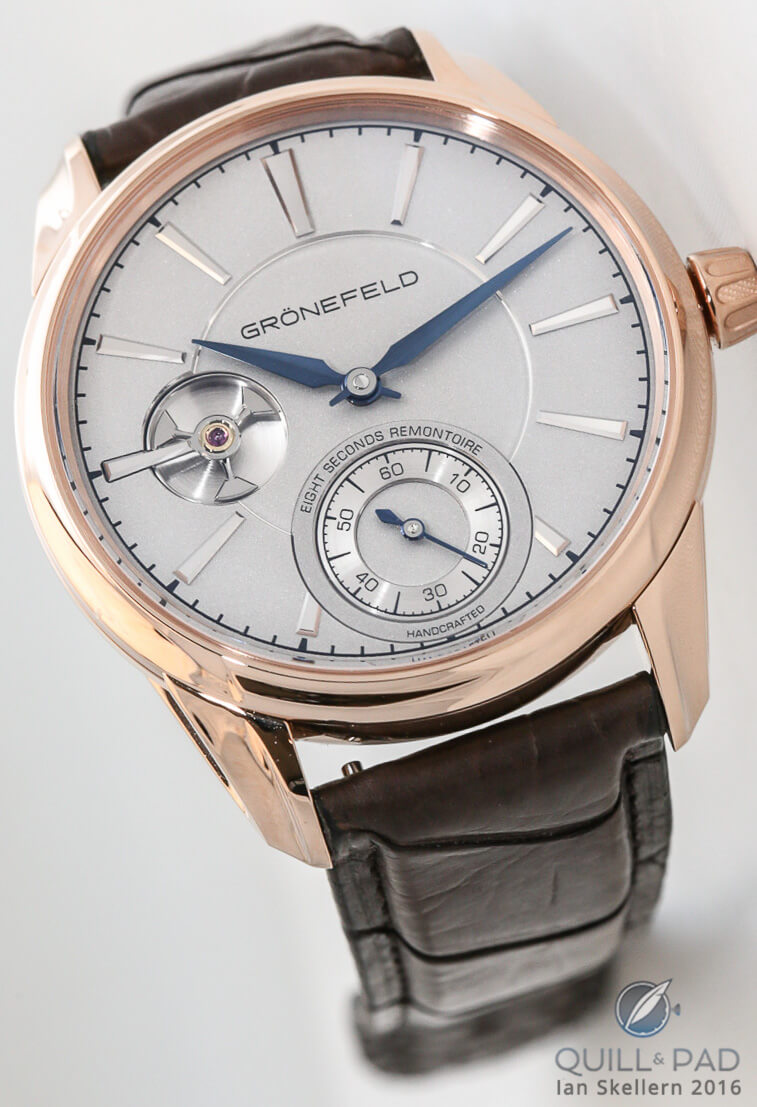
Grönefeld 1941 Remontoire in red gold with grey dial
The latest timepiece emerging from the royal halls of Steenstraat 2 in Oldenzaal (where the now three-generation-old workshop is located) is the 1941 Remontoire, an homage to the siblings’ forbearers.
Building a watch
The Grönefeld 1941 Remontoire is the next step in the ongoing evolution of the Grönefeld brothers and it references the history leading up to this moment. The watch’s concept revolves around a key feature – the remontoire – hence the name.
The remontoire holds a special place in the history of the Grönefeld family because the clock in Saint Plechelmus featured one to help drive its hands. This means that both Johan and Sjef spent their lives tending the remontoire, and the brothers now have created an increditastic piece featuring their take on this rare mechanism.
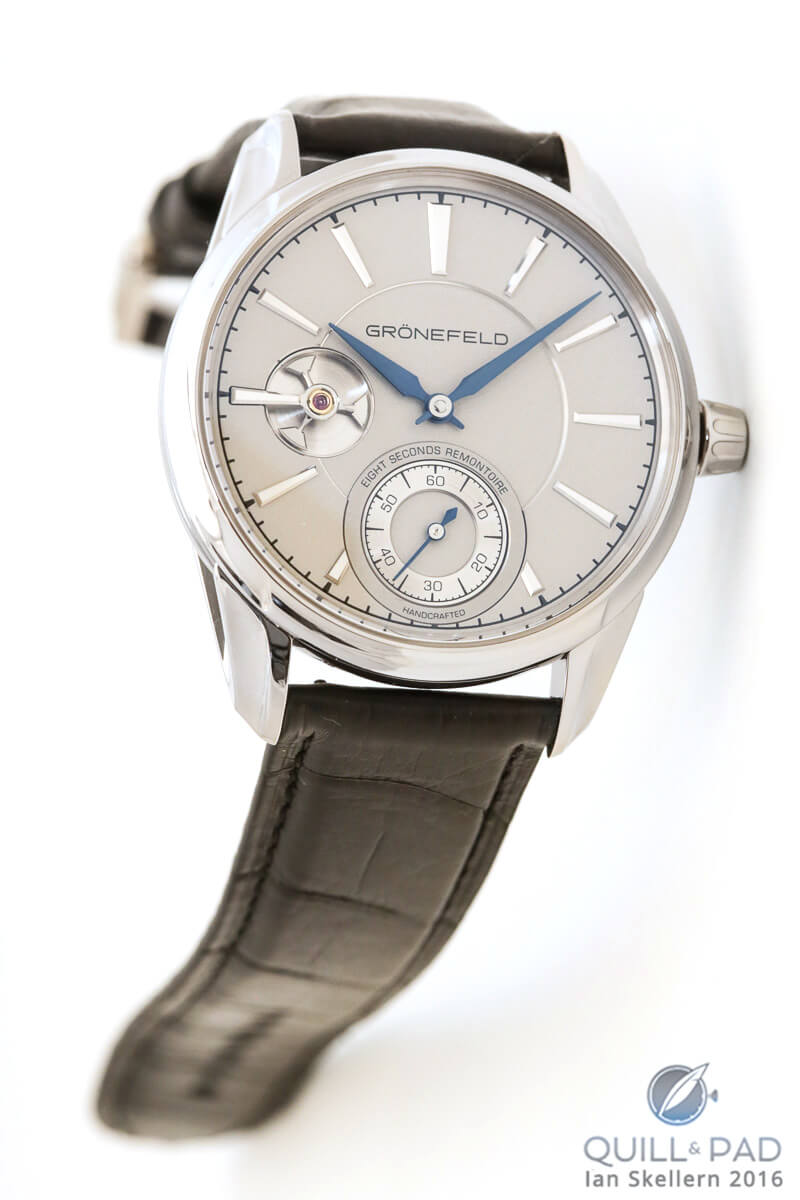
Grönefeld 1941 Remontoire in white gold with grey dial
A remontoire is a system designed to deliver consistent power to the balance and escapement thanks to a small spring attached to a wheel (usually the fourth wheel), which is released and recharged with its own escapement at predetermined intervals. This allows a much smaller force variation to the balance, which creates a more consistent rate for the watch compared to a normal mainspring unwinding.
Invented in a time when the metal used for mainsprings was of very low quality, the remontoire helped to create more accurate timekeepers until the invention of modern mainsprings and the advancements in metallurgy. Still, the mechanism is a very technical bit of engineering and allows for a broad interpretation that the Grönefeld brothers took full advantage of.
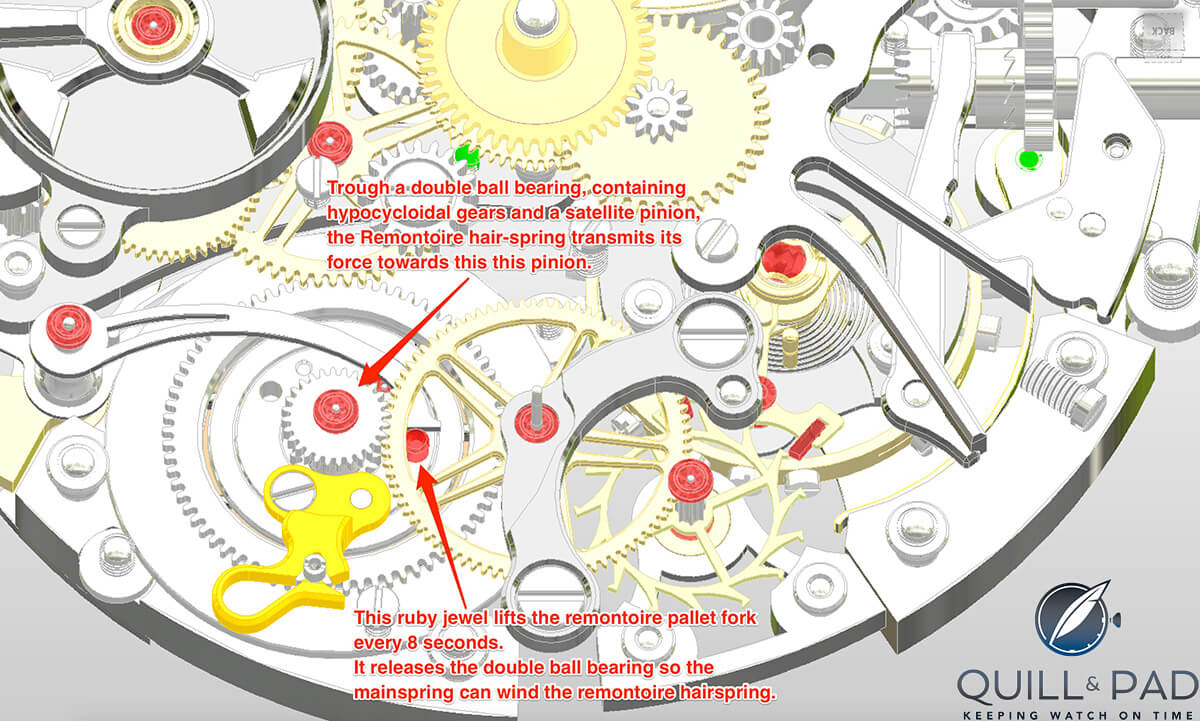
The Grönefeld remontoire mechanism (image courtesy Grönefeld)
It starts with a five-lobed cam wheel that isn’t continuously moving (nor is most of the gear train). Most of the gear train is being held by what is riding on the cam wheel, a three-jewel pallet anchor that releases every eight seconds. Two of the pallet stones switch back and forth to lock the cam wheel (while the third leg of the pallet anchor locks on something else that I’ll come back to in two paragraphs).
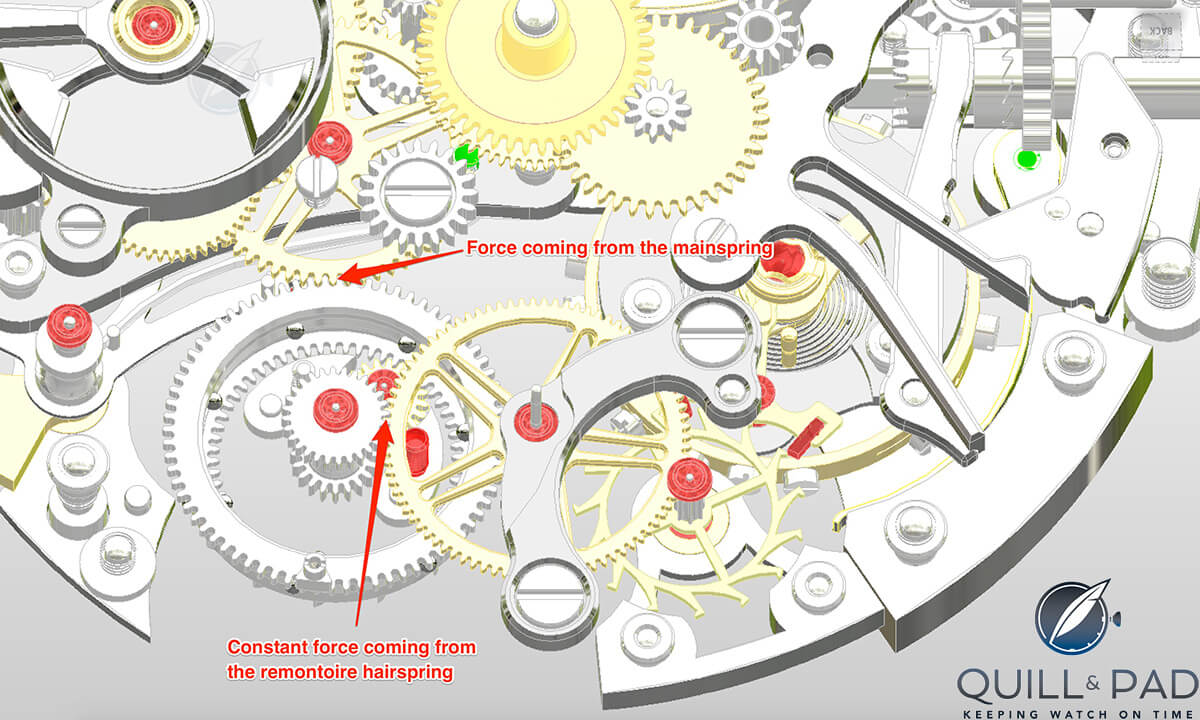
The Grönefeld remontoire mechanism (image courtesy Grönefeld)
During an eight-second time period the next components are powering the balance before being recharged. The gear train meshes with another wheel bearing a small spring attached near its center, which is attached to yet another wheel (this time on its rim) that meshes with a planetary gear system responsible for doling out constant power to the balance wheel and escapement.
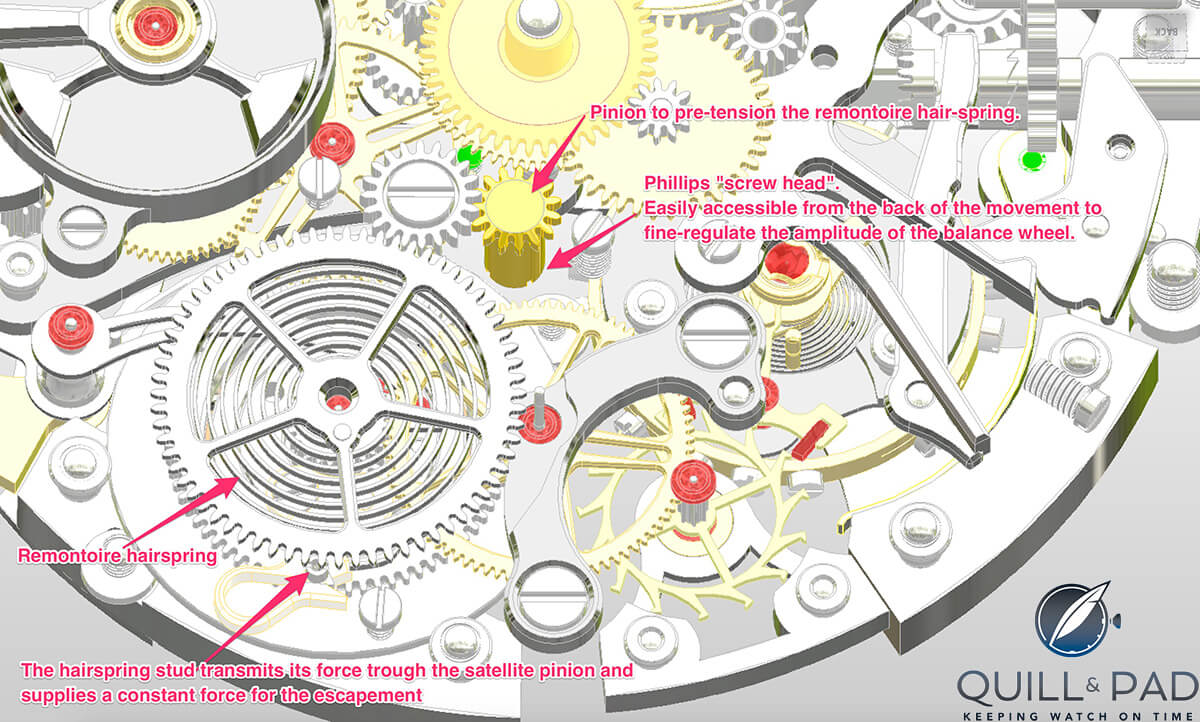
The Grönefeld remontoire mechanism (image courtesy Grönefeld)
This second wheel attached to the spring also has escapement teeth on the flip side that are locked by the third leg of the pallet anchor (I told you we’d come back to that).
Consistent power in a clever way
As the system runs, the balance beats 48 times (6 beats per second over 8 seconds) before the anchor is released. As this occurs, the cam wheel is also released, allowing one-fifth of a rotation, which moves the minute hand forward by a small but noticeable increment.
To ensure that this movement happens in a safe manner, the Grönefeld brothers inserted a tri-spoked governor that limits the gear train’s speed. This means that when the remontoire is released, the gear train glides forward instead of snapping ahead and potentially damaging the gearing.
It’s really a fantastic mechanism that strays from the remontoire construction norm (if we can use “norm” to describe this quite rare function). Elsewhere in the movement there are some other great features that add to the complexity and usability of the 1941 Remontoire such as the long curved spring next to the balance wheel that gently presses against its timing screws when the crown is pulled and stops its rotation, allowing for precise setting of the seconds (this is known as hacking or stop seconds).
And since there is the ability to set the watch very accurately, after going through all this effort to maintain a consistent rate once it’s set, some attention needed to be paid to the mainspring too. On the dial side of the mainspring barrel resides an eccentrically mounted ring gear that has a locking feature to limit the rotation of the barrel after a specific number of revolutions.
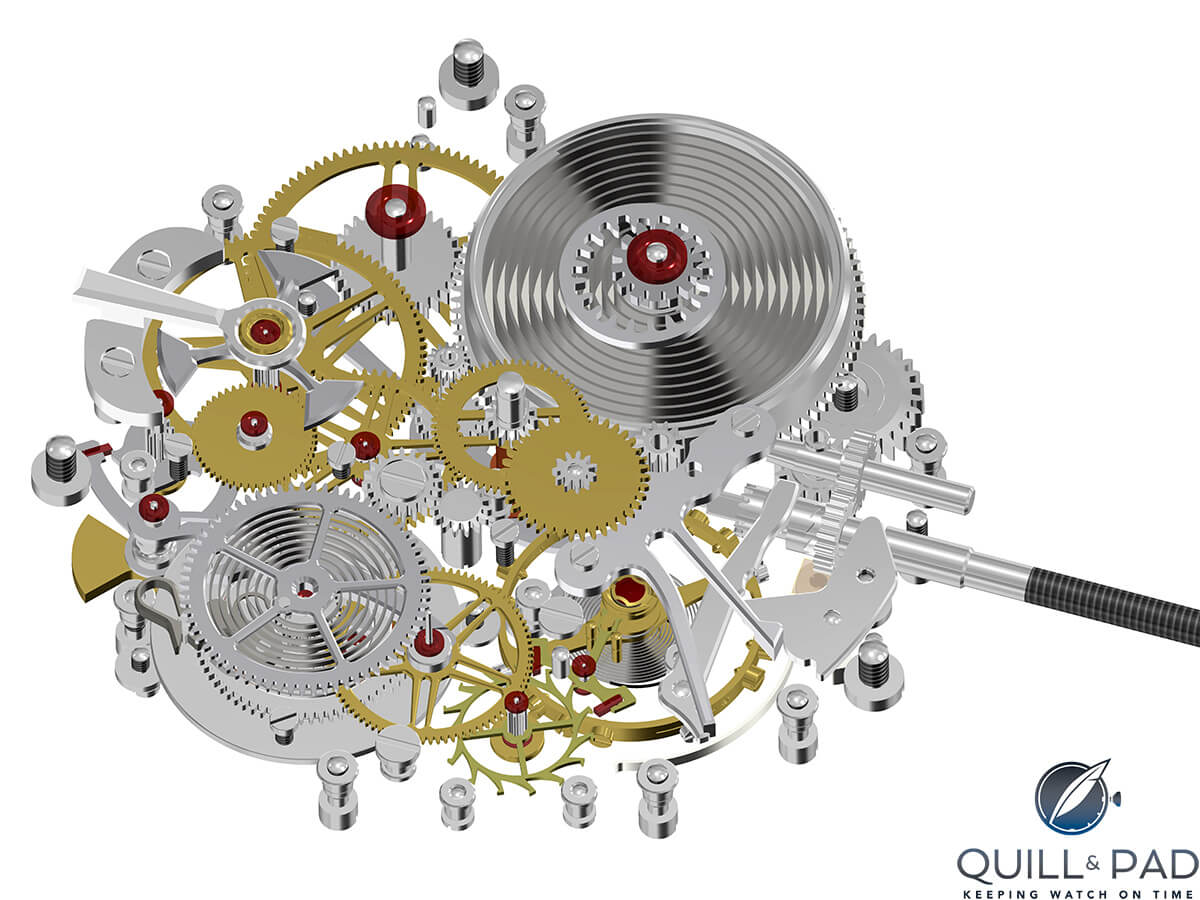
Technical illustration of the Grönefeld 1941 Remontoire movement (image courtesy Grönefeld)
This feature maintains that during the 36 hours of power reserve, the mainspring is providing as much power as it can, always ensuring that there is enough to fully rewind the remontoire spring. After calculating how much force that would take, a limit on the rotation of the barrel can be added so that the remontoire will always be providing the same amount of power and no less, ensuring as perfectly consistent power delivery as possible.
Interesting facts
Beyond the technical awesomeness of the movement there is far more of which to be appreciative. Take the remontoire’s time period: eight seconds is slightly unusual for a remontoire, which usually is built around a one-second release period (something that creates a dead beat second hand), and if not that then some number that fits neatly into 60 seconds – like five, ten, or fifteen seconds.
Eight seconds goes into sixty exactly 7.5 times; that’s not nearly as neat and tidy.
But if you multiply sixty minutes by sixty seconds and divide the result (3,600 seconds) by the remontoire’s period of eight seconds, you find that every hour the remontoire recharges 450 times – or 10,800 times a day, an altogether more rounded number.
Something else to note is that, as a dynasty-building watch, the movement utilizes an aspect of Dutch culture that you may have never noticed before. I know I didn’t. The shape of the bridges is actually inspired by the shape of local architecture, specifically the house facades and their “bell” gables.
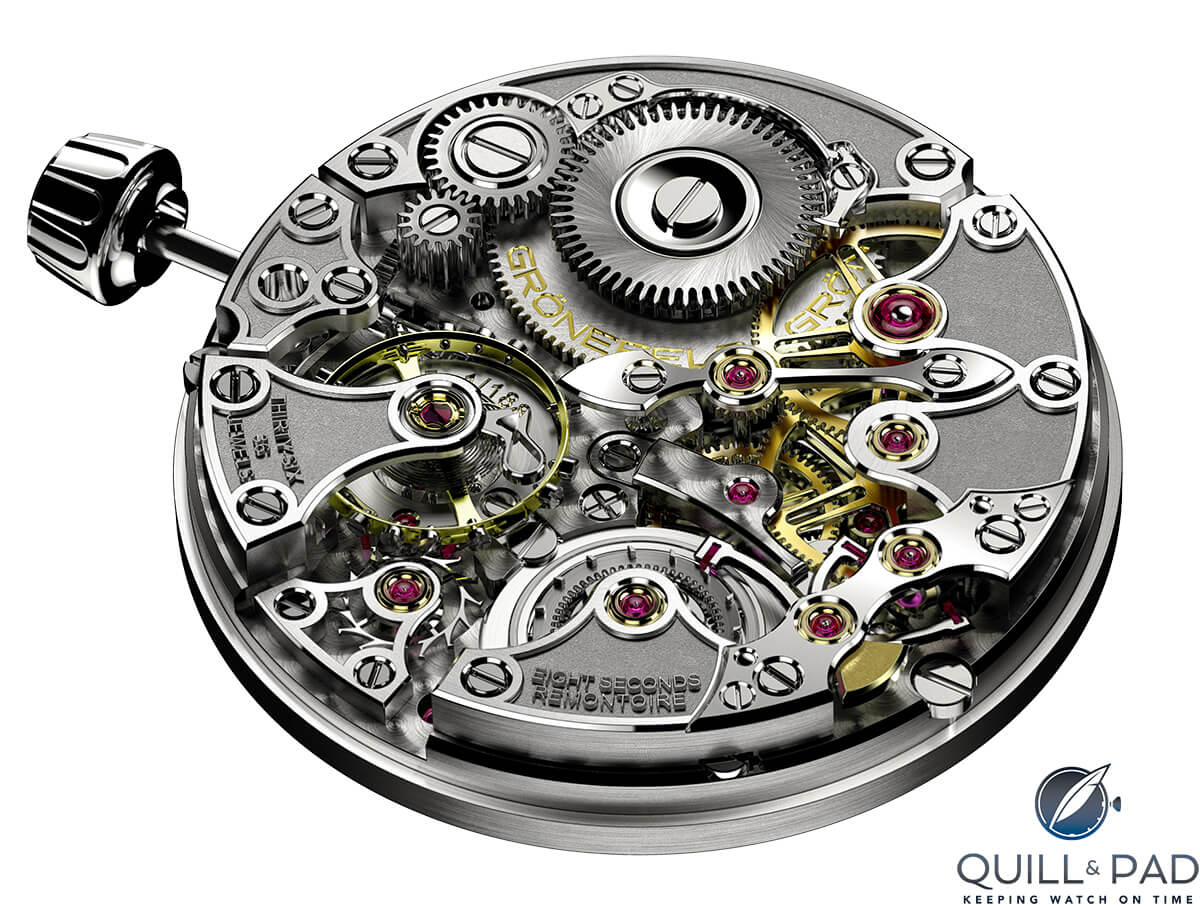
Movement of the Grönefeld 1941 Remontoire
This can even be seen on earlier Grönefeld watches like the One Hertz, but it is most pronounced in this new movement. Also new to the movement is the split five-spoke wheels that give a dramatic visual appeal to the gear train over previous models.
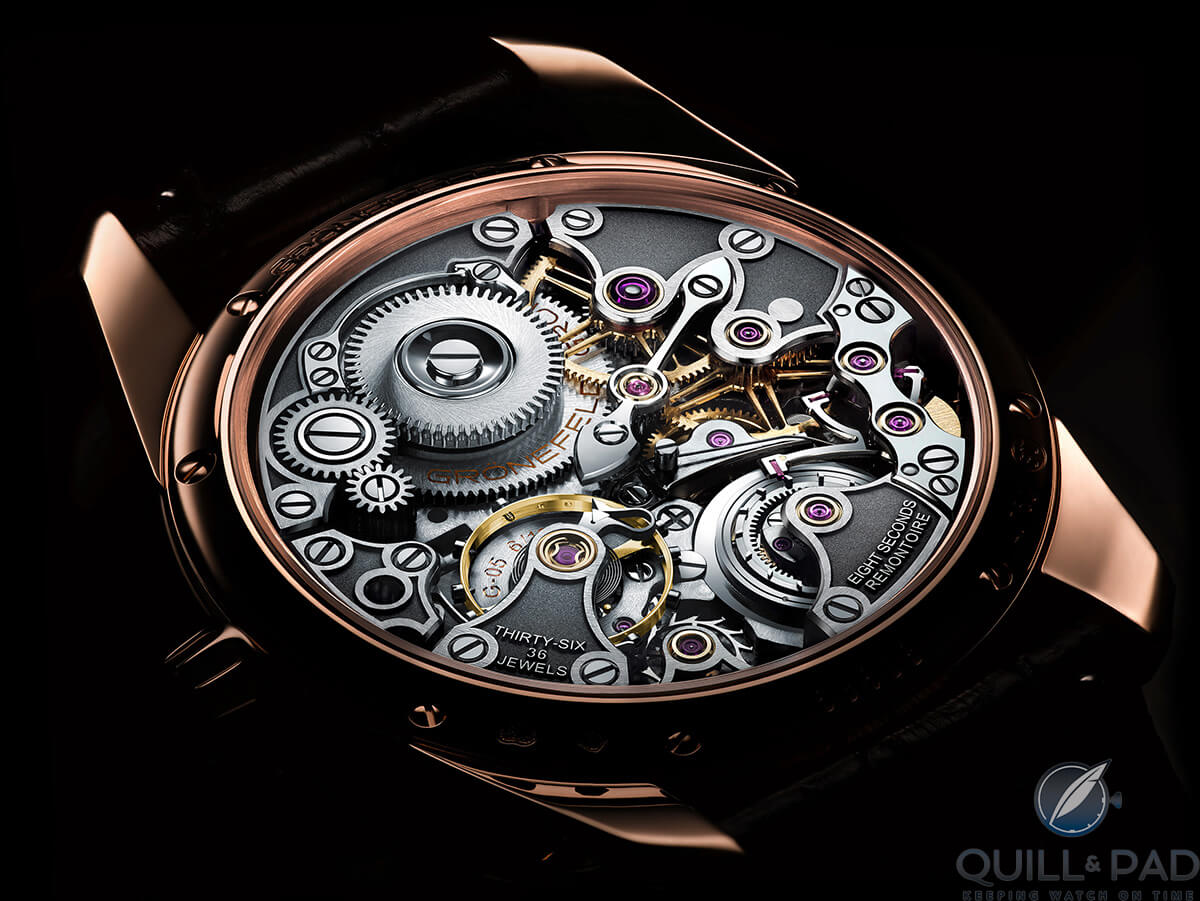
View through the display back of the Grönefeld 1941 Remontoire
Along with the new movement comes a new case and a new collection, the 1941. Named for Sjef Grönefeld’s year of birth, this is a direct homage to the man that inspired and raised Tim and Bart in the culture of watchmaking.
The case is a new design with much more detailed features like carved hollows in the lugs and the champagne cork style of crown. It feels much more sensuous and classic compared to the more modern cases from previous pieces.
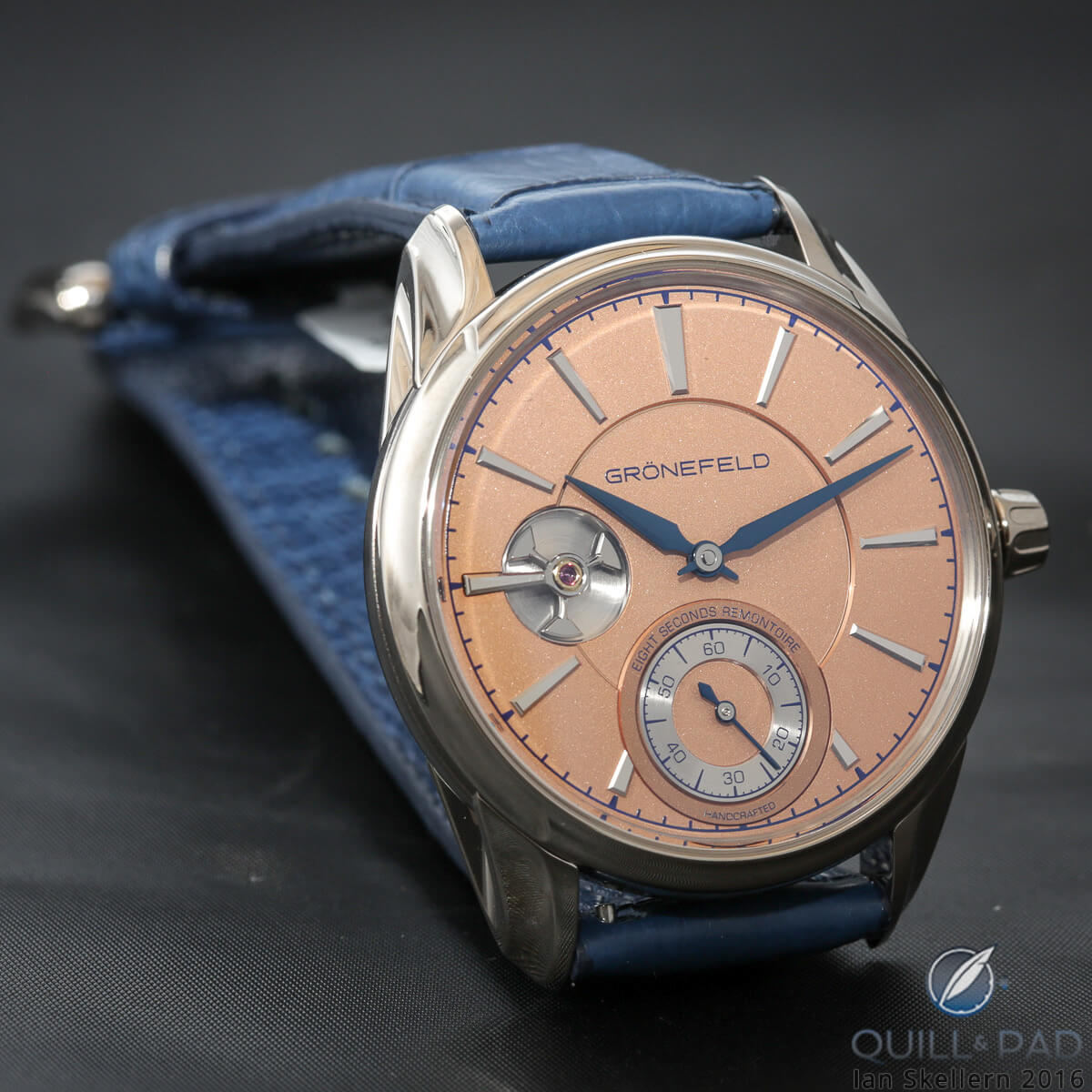
Grönefeld 1941 Remontoire in white gold with salmon-colored dial
Everything combines to make a simply stunning and technical piece that also happens to look classic and reserved at the same time, which is always a tough thing to pull off. But it seems like Tim and Bart have found some new winning ideas to add to the Grönefeld stable of skills.
The duo may not be openly trying to breathe life into a new dynasty, nor do they seem to have visions of grandeur between them. But given the pedigree that the family name has, and the leaps and bounds by which the Grönefeld brand is producing incredible pieces, it is perhaps only a matter of time before the name Grönefeld is uttered in the same way as the likes of Breguet, Patek, or the New York Yankees.
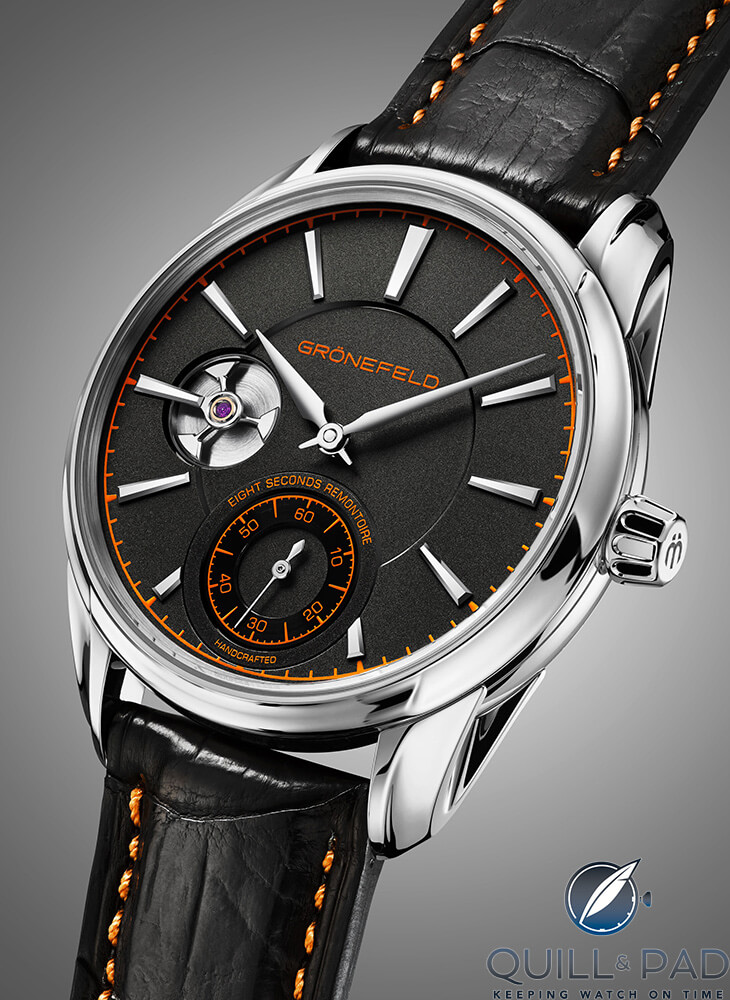
Grönefeld 1941 Remontoire in white gold with black dial
Dynasties are built over time by hard work, dedication, and some fantastic ideas. Tim and Bart have definitely shown they have what it takes to become not just the “Horological Brothers,” but just maybe the unofficial Horological House of Orange. The 1941 Remontoire proves that.
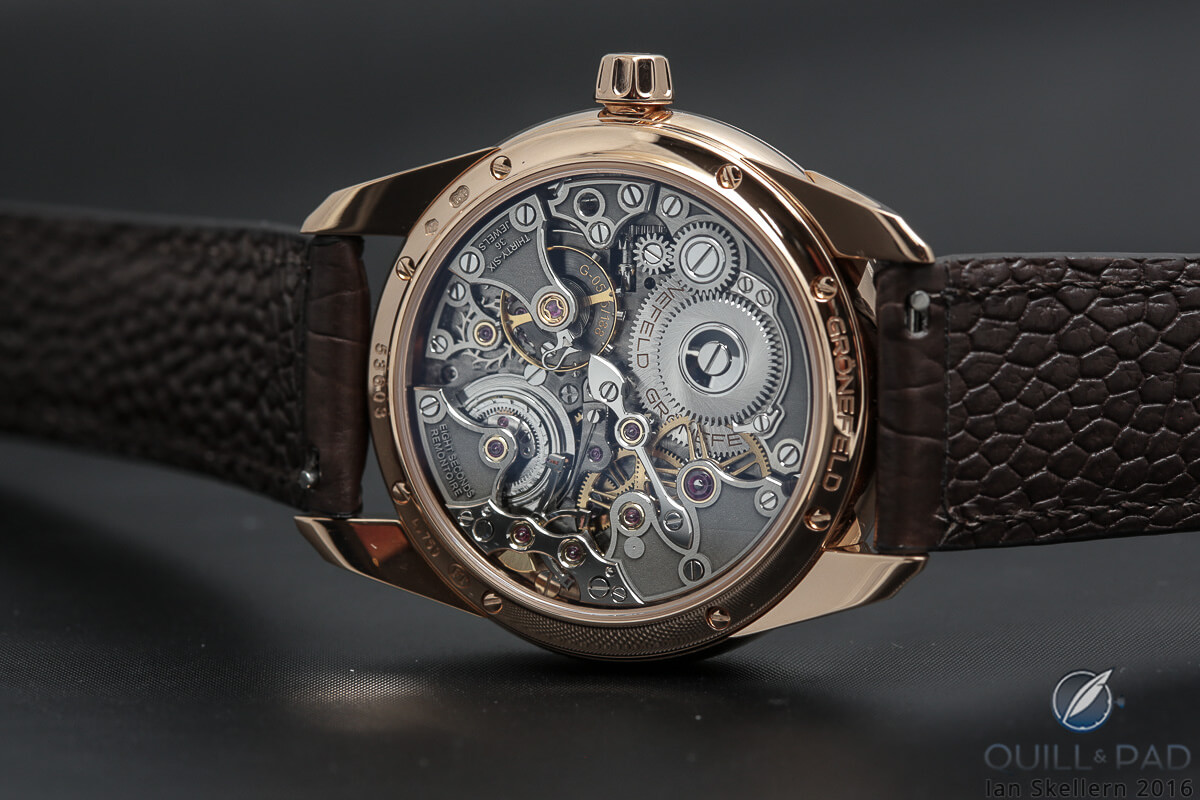
Back of the Grönefeld 1941 Remontoire revealing the beautiful movement within
It’s a break da-du-da-dun down!
- Wowza Factor * 9.9 This piece doesn’t get a perfect ten because it’s a bit of a secret agent thanks to the classically inspired dial and case. But the insides . . . wowza!
- Late Night Lust Appeal * 101.01 » 990.569 m/s2 No matter how you slice it, the lusting is real for this piece!
- M.G.R. * 68.9 A movement that was developed with the attributes of this one deserves nothing less than a top-notch geek rating. And we can probably agree that its looks match its engineering for excellence.
- Added-Functionitis * N/A Another one of those silly boring time-only watches. Just kidding, it’s not boring at all! But still there won’t be any need for the Gotta-HAVE-That cream.
- Ouch Outline * 12.1 Dropping a transmission on your foot in the middle of a junkyard. Let’s just say that I have not experienced this pain but I can imagine a situation where it might happen and, boy, would it be excruciating! But if I could get this watch, I might even volunteer for this one.
- Mermaid Moment* 8 seconds is enough! The governor spinning around every 8 seconds is just enough to let you know there is something special going on. Once you flip that watch over to see the movement, you might as well just book the Plaza for October!
- Awesome Total * 774 Multiply the number of components in the movement (258) with the depth rating in atmospheres (3) for a serious dynasty-building awesome total!
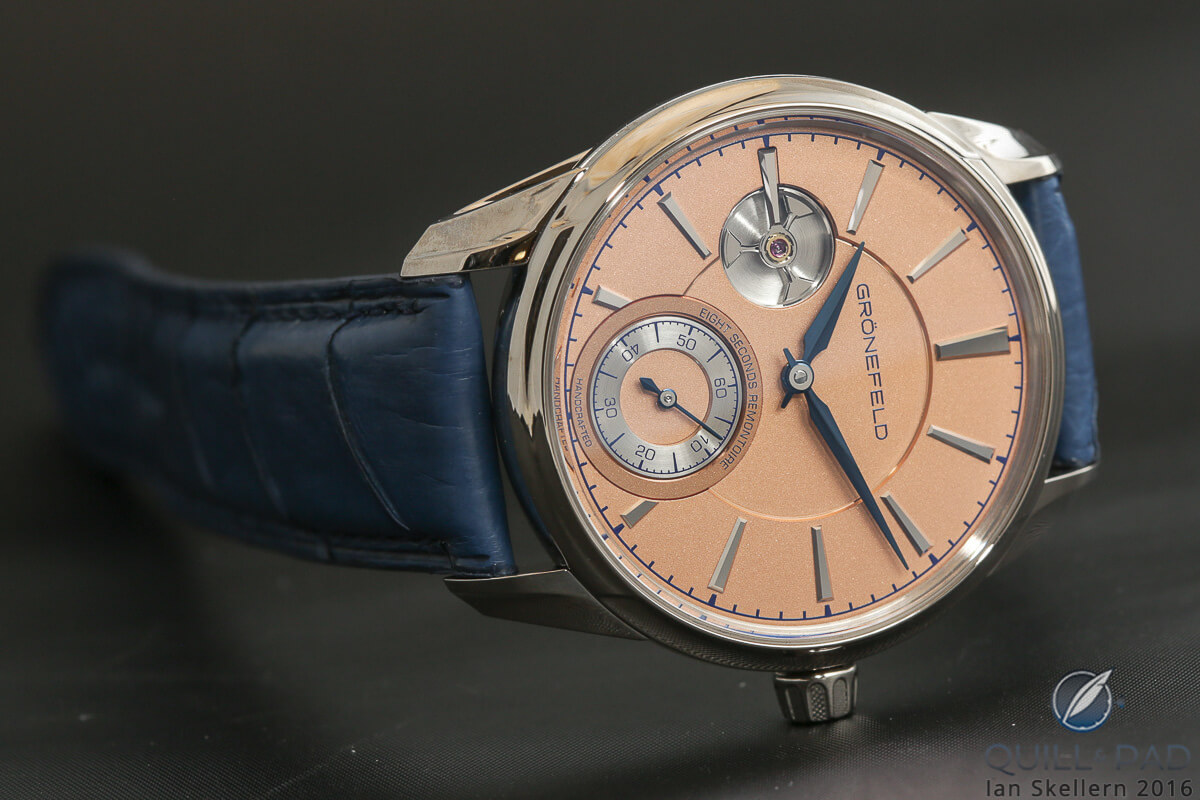
Grönefeld 1941 Remontoire in white gold with salmon-colored dial
For more information, please visit www.gronefeld.com/collection/1941-remontoire.
Quick Facts
Case: 39.5 x 10.5 mm, red or white gold
Movement: manually wound Caliber G-05 with 8-second remontoire
Functions: hours, minutes, seconds
Price: €49,500 for red gold and €50,850 for white gold
* This article was first published on Quill & Pad on July 3, 2016 at Grönefeld 1941 Remontoire In The Horological House Of Orange.
Leave a Reply
Want to join the discussion?Feel free to contribute!



Great article and and a well explained overview of the workings of the remontoire feature. This is certainly a deserving winner. That movement is definitely something to behold.